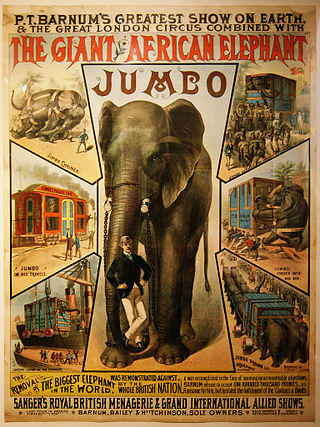
Jumbo, also known as Jumbo the Elephant and Jumbo the Circus Elephant, was a 19th-century male African bush elephant born in Sudan. Jumbo was exported to Jardin des Plantes, a zoo in Paris, and then transferred in 1865 to London Zoo in England. Despite public protest, Jumbo was sold to P. T. Barnum, who took him to the United States for exhibition in March 1882.

Chiang Mai is the second largest Province (changwat) of Thailand. It lies in upper northern Thailand and has a population of 1.78 million people. It is bordered by Chiang Rai to the northeast, Lampang and Lamphun to the south, Tak to the southwest, Mae Hong Son to the west, and Shan State of Burma to the north. The capital, Chiang Mai, is 685 kilometres (426 mi) north of Bangkok.

Mandalay is the second-largest city in Myanmar, after Yangon. Located on the east bank of the Irrawaddy River, 631 km north of Yangon, the city has a population of 1,225,553.

The North East Line (NEL) is a high-capacity Mass Rapid Transit (MRT) line in Singapore. Operated by SBS Transit, the 20-kilometre (12 mi) line is the MRT's shortest. It runs from HarbourFront station in southern Singapore to Punggol station in the northeast, serving 16 stations via Chinatown, Little India, Serangoon and Hougang. Coloured purple on official maps, it is Singapore's third MRT line and the world's first fully-automated underground driverless heavy rail line.
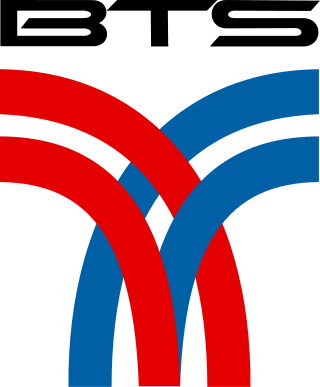
The Bangkok Mass Transit System, commonly known as the BTS Skytrain, is an elevated rapid transit system in Bangkok, Thailand. It is operated by Bangkok Mass Transit System PCL (BTSC), a subsidiary of BTS Group Holdings, under a concession granted by the Bangkok Metropolitan Administration (BMA) which owns the lines. The system consists of 62 stations along three lines with a combined route length of 70.05 kilometers (43.53 mi). The BTS Sukhumvit Line runs northwards and south-eastwards, terminating at Khu Khot and Kheha respectively. The BTS Silom Line which serves Silom and Sathon Roads, the central business district of Bangkok, terminates at National Stadium and Bang Wa. The Gold Line people mover runs from Krung Thon Buri to Klong San and serves Iconsiam. The lines interchange at Siam station and Krung Thon Buri. The system is formally known as "The Elevated Train in Commemoration of HM the King's 6th Cycle Birthday".

The Ringling Bros. and Barnum & Bailey Circus, also known as the Ringling Bros. Circus, Ringling Bros., the Barnum & Bailey Circus, Barnum & Bailey, or simply Ringling, is an American traveling circus company billed as The Greatest Show on Earth. It and its predecessor have run shows from 1871, with a hiatus from 2017 to 2023. They operate as Ringling Bros. and Barnum & Bailey. The circus started in 1919 when the Barnum & Bailey's Greatest Show on Earth, a circus created by P. T. Barnum and James Anthony Bailey, was merged with the Ringling Bros. World's Greatest Shows. The Ringling brothers purchased Barnum & Bailey Ltd. in 1907 following Bailey's death in 1906, but ran the circuses separately until they were merged in 1919.
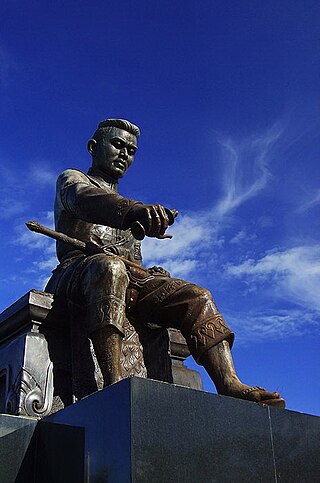
King Naresuan the Great was the 18th monarch of Ayutthaya Kingdom and 2nd monarch of the Sukhothai dynasty. He was the king of the Ayutthaya Kingdom from 1590 and overlord of Lan Na from 1602 until his death in 1605. Naresuan is one of Thailand's most revered monarchs as he is known for his campaigns to free Ayutthaya from the vassalage of the Taungoo Empire. During his reign, numerous wars were fought against Taungoo Burma. Naresuan also welcomed the Dutch.

The Surin Elephant Round-up is a cultural festival held every year in Surin Province, Isan, Thailand. Usually the event is organized during the third week of November on the weekend. The festival has its origins in the royal hunts which were conducted in Surin Province during medieval times. The indigenous residents of Surin, the Kuy, have been traditional practitioners of corralling elephants and training them as working animals. When the Ayutthaya Kingdom came into power these hunts were converted into a public extravaganza and wild elephants were replaced with tame ones. The festival, in its contemporary form, was first organized in the 1960s when civil war in Cambodia and the steady decline in economic value of elephants forced the elephant handlers (mahouts) to seek occupations in the entertainment and tourism industry.

Lampang, also called Nakhon Lampang to differentiate from Lampang province, is the third largest city in northern Thailand and capital of Lampang province and the Mueang Lampang district. Traditional names for Lampang include Wiang Lakon and Khelang Nakhon. The city is a trading and transportation center. Lampang lies 601 km (373 mi) north of Bangkok and 101 km (63 mi) southeast of Chiang Mai.
The Thai Elephant Orchestra is a musical ensemble consisting of as many as fourteen Thai elephants near Lampang in Northern Thailand. The elephants play music, essentially as conducted improvisations, on specially designed heavy-duty musical instruments. The orchestra was co-created by elephant conservationist Richard Lair of the National Elephant Institute and the American musical artist and neuroscientist Dave Soldier. They have released three CDs on the Mulatta Records label with an orchestra ranging in size from six to fourteen elephants.
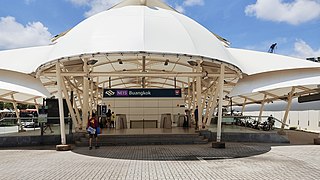
Buangkok MRT station is an underground Mass Rapid Transit (MRT) station on the North East line (NEL) in Sengkang, Singapore. Located underneath Sengkang Central near the junction with Compassvale Bow, Buangkok station is one of the two MRT stations located within the Sengkang planning area and serves the town of Buangkok. The station is operated by SBS Transit.
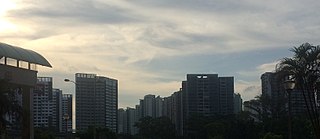
Fernvale is a neighbourhood of Sengkang New Town in Singapore. It is located between Sungei Punggol and the proposed Sengkang West Industrial Estate. The house numbers of the public apartment blocks in Fernvale begin with the number '4' (4xx). Fernvale is the newest neighbourhood in Sengkang Town to be completed by the Housing and Development Board (HDB). Seletar Mall, a new shopping amenity which houses Sengkang's first cineplex, is located within this neighbourhood. In 2017, a proposed community facility to be located next to Seletar Mall was announced, which houses a community club, childcare centre, hawker centre and wet market. The community facility which was slated to be ready by the second half of 2020, had stopped construction in April 2020 due to the COVID-19 measures set by the government. Construction of the facility has since continued in the second half of 2020 and was completed in 2022.

A white elephant is a rare kind of elephant, but not a distinct species. Although often depicted as snow white, their skin is typically a soft reddish-brown, turning a light pink when wet. They have fair eyelashes and toenails. The traditional "white elephant" is commonly misunderstood as being albino, but the Thai term, chang samkhan, actually translates as 'auspicious elephant', being "white" in terms of an aspect of purity.
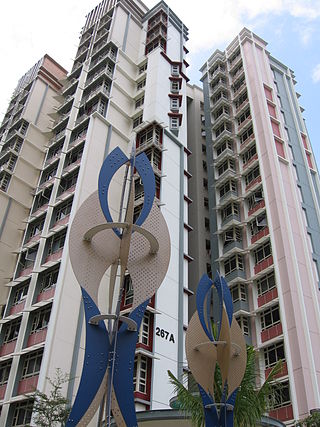
Buangkok is a neighbourhood located in north eastern Singapore. Whilst its boundaries are vague, the neighbourhood is roughly spread across the Trafalgar and Compassvale subzones of the Hougang and Sengkang Planning Areas respectively, as designated by the URA.
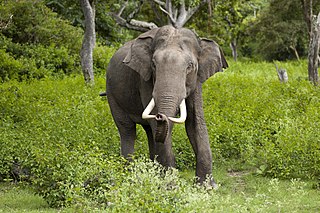
The Indian elephant is one of three extant recognized subspecies of the Asian elephant, native to mainland Asia. The species is smaller than the African elephant species with a convex back and the highest body point on its head. The species exhibits significant sexual dimorphism with a male reaching an average shoulder height of about 3.2 m (10 ft) and weighing up to 5,400 kg (11,900 lb) whereas a female reaches an average shoulder height of about 2.54 m (8.3 ft) and weighs up to 4,160 kg (9,170 lb). It has a broader skull with a concave forehead, two large laterally folded ears and a large trunk. It has grey colored smooth skin with four large legs and a long tail.

Siem Reap is the second-largest city of Cambodia, as well as the capital and largest city of Siem Reap Province in northwestern Cambodia.
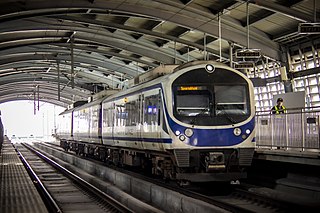
The Airport Rail Link (ARL) is an express and commuter rail line in Bangkok, Thailand. The line provides an airport rail link from Suvarnabhumi Airport, via Makkasan station, to Phaya Thai station in central Bangkok. Most of the line is on a viaduct over the main eastern railway. It is owned by State Railway of Thailand (SRT) and, since 2021, operated by Asia Era One Company Limited. The 28.6-kilometer (17.8 mi)-long Airport Rail Link opened for service on 23 August 2010.
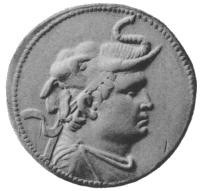
Elephants have been depicted in mythology, symbolism and popular culture. They are both revered in religion and respected for their prowess in war. They also have negative connotations such as being a symbol for an unnecessary burden. Ever since the Stone Age, when elephants were represented by ancient petroglyphs and cave art, they have been portrayed in various forms of art, including pictures, sculptures, music, film, and even architecture.
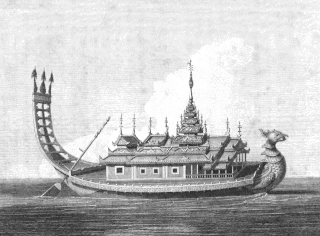
A royal barge is a ceremonial barge that is used by a monarch for processions and transport on a body of water.
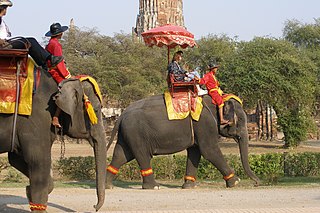
The elephant has been a contributor to Thai society and its icon for many centuries. The elephant has had a considerable impact on Thai culture. The Thai elephant is the official national animal of Thailand. The elephant found in Thailand is the Indian elephant, a subspecies of the Asian elephant. In the early-1900s there were an estimated 100,000 captive elephants in Thailand. In mid-2007 there were an estimated 3,456 captive elephants left in Thailand and roughly a thousand wild elephants. By 2017 the number of captive elephants had risen to an estimated 3,783. The elephant became an endangered species in Thailand in 1986.




















